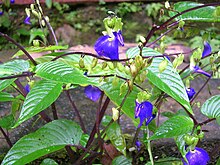
Gesneriaceae, the gesneriad family, is a family of flowering plants consisting of about 152 genera and ca. 3,540 species in the tropics and subtropics of the Old World and the New World, with a very small number extending to temperate areas. Many species have colorful and showy flowers and are cultivated as ornamental plants.
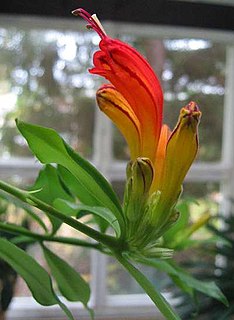
Aeschynanthus is a genus of about 150 species of evergreen subtropical and tropical plants in the family Gesneriaceae. They are usually trailing epiphytes with brightly colored flowers that are pollinated by sunbirds. The genus name comes from a contraction of aischuno and anthos (flower). The common name for some species is "lipstick plant", which comes from the appearance of the developing buds. A full list of the accepted species and their synonyms can be found in the Smithsonian Institution's World Checklist of Gesneriaceae.

Streptocarpus sect. Saintpaulia is a section within Streptocarpus subgenus Streptocarpella consisting of about ten species of herbaceous perennial flowering plants in the family Gesneriaceae, native to Tanzania and adjacent southeastern Kenya in eastern tropical Africa. The section was previously treated as a separate genus, Saintpaulia, but molecular phylogenetic studies showed that it was nested within the genus Streptocarpus.
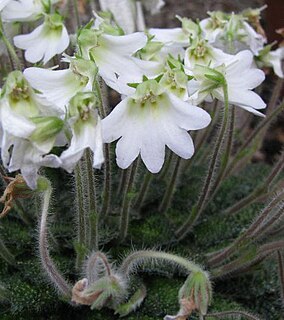
Petrocosmea is a genus of the family Gesneriaceae, the African violet family. Most of the species within this genus are endemic to high-altitude areas in Western China, although some are native to other parts of Asia. It is a rosette forming genus that generally grows on wet mossy rocks or forests.

Brian Laurence "Bill" Burtt FRSE FLS, was an English botanist and taxonomist who is noted for his contributions to the family Gesneriaceae. In a career that spanned 74 years, he worked first at the Royal Botanic Gardens, Kew, and then at the Royal Botanic Garden Edinburgh (RBGE). He made numerous field trips to South Africa and Sarawak and described a total of 637 new plant species. Burtt is denoted by the author abbreviation B.L.Burtt when citing a botanical name.
Briggsia was a genus in the family Gesneriacae that consisted of 22 species of herbaceous perennials, native to the Himalayas, China and Vietnam. The genus is no longer recognized, with all of its member species having been relocated to other genera, including Glabrella, Loxostigma, and Oreocharis.
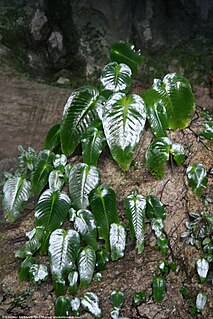
Monophyllaea is a genus of plants in the family Gesneriaceae. It contains the following species :
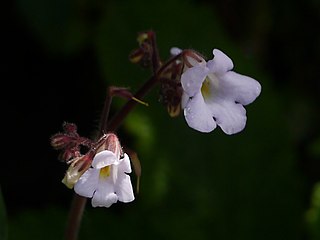
Henckelia is a genus of flowering plants in the family Gesneriaceae. Many of its species were formerly placed in Didymocarpus sect. Orthoboea and in the genus Chirita. Many species formerly placed in Henckelia have been moved to Codonoboea and Loxocarpus.

Codonoboea is a genus of flowering plants in the family Gesneriaceae. Many of its species were formerly placed in the genus Henckelia.
Loxocarpus is a genus of flowering plants in the family Gesneriaceae. Many of its species were formerly placed in the genus Henckelia.

Deinostigma is a genus in the family Gesneriaceae, native to Vietnam and Southern China. In 2016 the genus was expanded with the transfer of several species that had previously been place in the genus Primulina, to include a total of seven species.

The Didymocarpoideae are a subfamily of plants in the family Gesneriaceae. It was formerly the subfamily Cyrtandroideae. This subfamily consists mostly of tropical and subtropical Old World genera, found in Africa, Asia and the Pacific. One species is native to Central and South America.
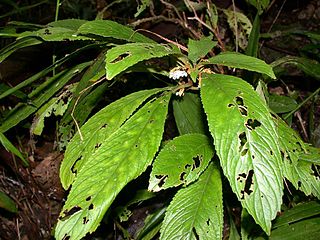
Rhynchotechum is a genus of plants in the family Gesneriaceae, subfamily Didymocarpoideae. Species distribution records are mostly from India, Sri Lanka, China through to southern Japan, Indo-China and Malesia through to New Guinea.

Lysionotus is a genus of flowering plants in the family Gesneriaceae. It occurs in the Himalayas, China, Japan, and Southeast Asia. The genus was described by David Don in 1822.
Paraboea are a genus of flowering plants in the African violet family Gesneriaceae, native to southern China, Assam, Indochina, and Malesia. They were recircumscribed from Boea in 2016.

Damrongia is a genus of flowering plants in the Gesneriad family, centered in Thailand and found in southern China, Southeast Asia, and Sumatra. Species were reassigned to it in 2016 in a revision of Loxocarpinae.
Stauranthera is a genus of flowering plants in the family Gesneriaceae, native to Bangladesh, the Nicobar Islands, Assam, the eastern Himalayas, south-central and southeast China, Southeast Asia, and Malesia to New Guinea. It is very close morphologically and genetically to Loxonia.
Beccarinda is a genus of flowering plants belonging to the family Gesneriaceae.
Boeica is a genus of flowering plants belonging to the family Gesneriaceae.
Fieldia is a genus of flowering plants in the family Gesneriaceae, native to New South Wales, Queensland and Victoria in Australia. It has at times been treated as monotypic, with one species, F. australis. Two are accepted as of April 2021 by sources that include Lenbrassia in Fieldia.
